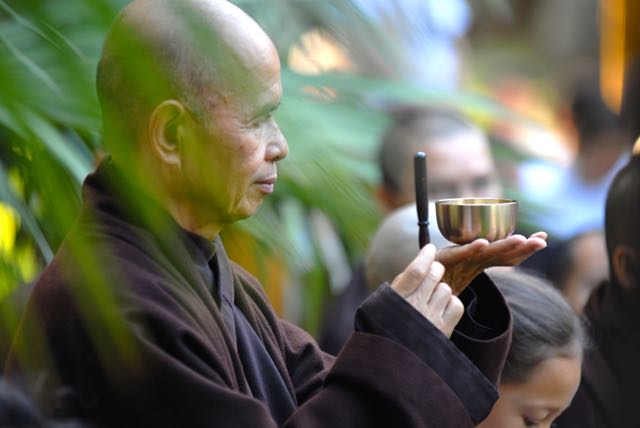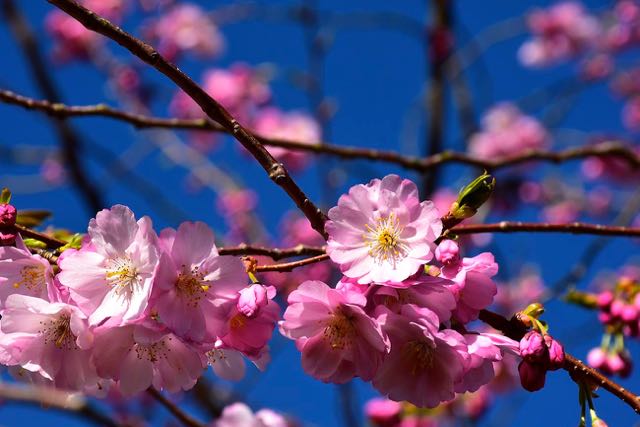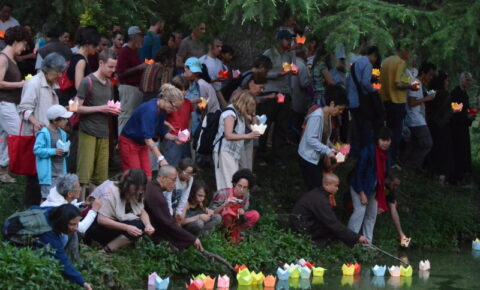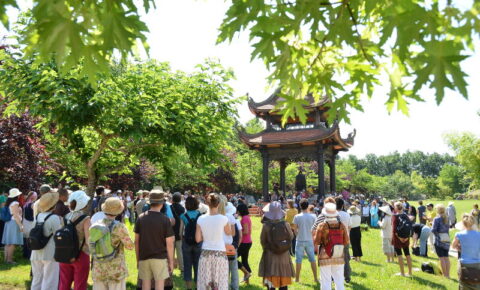Transcript of Dharma Talk given by Thay in Plum Village on 28 July 2006
This year, while I was leading a retreat in the Netherlands and a Day of Mindfulness in Belgium, I learned that our Dharma Teacher Karl Schmied died in Germany. He was a good Dharma Teacher. He began with practicing Tibetan Buddhism, but when he came to a retreat offered by Thay in Germany, he liked it very much so he continued to study and practice with us. He helped organize many retreats in Germany for Thay and the Plum Village Sangha. He was an excellent Sangha builder. Every time we landed in Germany, it was he who welcomed us at the airport, and every time we left Germany, he was always at the airport to see us off for many, many years. The Sangha in Germany has grown into a very big, solid Sangha. There are many members of the Order of Interbeing.

In Germany, every two years there is a big gathering of Protestants, and Karl arranged it so that every time, Thay could attend and give a talk. One time after a talk, five thousand people, mostly Christians, joined me to practice walking meditation in Frankfurt. The police arranged for us to practice walking meditation on the boulevards in Frankfurt. It was very beautiful.
Karl’s dharma name was True Dharma Eyes. Thay transmitted the lamp to him to be a lay Dharma Teacher of Plum Village. After that, Karl led many retreats in Austria, Germany, Italy, and so on. When I heard that he was very sick, I asked Sister Chan Khong to come with me and visit him in his home. We spent two days and two nights with him. We knew that he was dying and he also knew that he was dying. I felt very lucky to have the opportunity to be there and spend a few days with him. We did not meet other people at all. We just stayed with him and spent time sitting together. He was a successful businessman. He had a very expensive, beautiful car made in Japan. When you sit in his car, you don’t feel that you are going very fast, but I was mindful and I saw that the car went very fast. That is why when we had a chance to stop the car and do some walking in the woods, I collected a small pine cone and offered it to him. I said to him, “Karl, every time you see this pine cone, you know that you have to go more slowly.” So he kept that pine cone in order not to talk while driving and not to go too fast. And he kept his promise.
I remember one time after Karl’s first retreat, he said goodbye to us in order to go to a business meeting in the South of Germany. I asked him whether it was possible not to go to the meeting and attend the second retreat. He said, “No, it is not possible.” But when I finished the orientation talk at the second retreat, I saw that he was sitting in the crowd. It turned out that while driving, he was reflecting on what Thay had said during the first retreat, that you have to learn how to release your cows. If you have too many cows to take care of, then you have no time.
Many of you may not have heard about cow releasing. The story is like this: One day the Buddha was sitting with his monks in the woods. They had just finished their mindful lunch and were about to start a question and answer session. A peasant passed by and asked the Buddha, “Dear monk, have you seen my cows passing by here?”
The Buddha said, “What cows?”
“My cows, six of them, I don’t know why but this morning they all ran away. I had also cultivated three acres of sesame seeds, but this year the insects ate them all. I think I am going to kill myself. I have lost everything!”
The Buddha said, “Dear friend, we have not seen your cows passing by here. You better look for them in the other direction.” After the farmer had gone, the Buddha looked at his monks and smiled and said, “My dear friends, do you know that you are lucky, you do not have any cows to lose.”

Sometimes, we possess a number of things, and we think that these possessions are very crucial to our happiness, our safety. But if you look deeply, you’ll see that maybe what you possess are obstacles for your happiness. If you know how to let them go, to release your cow, happiness becomes possible.
During the Dharma talk, I advised people to write down the names of their cows on a sheet of paper and to look deeply to see whether they are truly essential for their happiness. Otherwise, they should learn to release their cows. You have an idea as to how you can be happy, and you are stuck in that idea. That idea is a cow, a big cow. If you cannot get that position, you cannot be happy, that is a cow, a big cow. If you cannot get that diploma, you suffer all your life, and this is a cow. Sometimes, our cow is our belief in a kind of doctrine, a kind of ideology. You think that happiness will not be possible without that doctrine, that ideology. There are countries that hold onto their ideology for fifty years, seventy years. They suffer a lot before they can release their cow. So the most difficult cow to release is your idea about your happiness. And there are other cows around you, you think that you cannot survive without these cows. But in fact you suffer because of them. So halfway to the meeting, Karl decided to release his cow, he made a U-turn and came back to the retreat.
We all suffered when we learned that he died. But looking deeply, we see that he continues to be there in other form, because what he had done, had said, are still there – those are his continuation. He continues to build the Sangha. He continues to serve as the ground of the practice. So it is not true that after death he does not continue. We continue with our karma. When you produce a thought, that thought bears your signature – that is your continuation. When you say something, that statement carries your signature – that is your continuation. When you do something, the action also carries your signature – that is your continuation.
Whether we continue beautifully or not is up to us. If you produce beautiful thoughts, speech and actions, then your continuation will be beautiful. Every one of us cares about a beautiful continuation. I myself also care about a beautiful continuation.
The disintegration of this body does not mean the end of me, no. It is like my pot of tea. There are tea leaves inside. When I pour hot water in it, the essence, the most essential of the tea comes out into the water, and I drink the tea. When I pour hot water for the second time, the tea becomes weaker and I still enjoy it. But if you keep pouring new hot water, then the tea leaves that remain have lost most of the essence. The tea I drink may continue in the form of a poem, in the form of a thought, in the form of a Dharma Talk. If you look deeply, you’ll see the continuation of the tea. What is left in the teapot is not truly the tea anymore. It is just a little bit of residue that you can put in the ground to nourish plants. So when we die, the disintegration of this body is only the residue, not much. The best things in us have gone in terms of karma – in terms of thought, speech and action – and that is our true continuation. So we should care about our continuation by taking care of our thought, our speech, and our action. Because nothing is lost, rien ne se perdre. This is true. That kind of energy will come together and that will allow us to manifest again as a continuation.
So, to die does not mean that from something you become nothing, from someone you become no one. That is not true. We should have time to reflect on that. To die, in our minds, means that from someone, you suddenly become no one. That is not the truth. It is not true that from something you become nothing. When you look deeply into something like a cloud, you see that the nature of the cloud is the nature of no birth and no death. What does it mean to be born? In our mind, to be born means that from nothing, we suddenly become something. From no one, we suddenly become someone. That is our definition of birth. But looking deeply, practicing meditation, you see that there is nothing like that in the world. A cloud does not come from nothing. A cloud is a continuation of the water in the lake, in the ocean; a continuation of heat and so on. So the birth of a cloud means manifestation, a new manifestation.
When a cloud dies, what does it mean? A cloud cannot die, a cloud can only become something else, like rain, hale, snow, ice, or tea. A cloud cannot just become nothing. Imagine a cloud floating in the sky and half of it begins to be transformed into rain. Visualize the half cloud looking down and see half of herself becoming a stream of water and the cloud is smiling to herself in her new manifestation. Nothing is lost. To be a cloud floating in the sky is beautiful. To become the rain falling on the hills, on the grass, becoming one with the river is also wonderful. Why are we afraid of dying? There is no death. There is only transformation, new manifestation. You should have the time to look deeply. There is a fear that one day we will get old, we will die, and that is why the practice of meditation, the practice of deep looking can help us transcend birth and death.
When I was a novice monk, I thought it was a difficult practice. But as I grew up, I see that it is not so difficult. You might touch your immortality, your nature of no birth and no death, just by looking deeply. Scientists, if they do well, can also find that truth. The French scientist Lavoisier said that nothing is born, nothing dies. He practiced looking deeply into matter, and realized that “Rien ne se créer, rien ne se perdre.”
If it is so, why should we be afraid of being born or dying? Looking at anything, like a flower, a cloud, or a bird, you can touch the nature of no birth and no death, and that is the ultimate aim of Buddhist meditation – to touch your own nature of no birth and no death. With that kind of realization, fear is no longer in us. True happiness can only be there when there is no fear. With fear inside, true happiness will not be possible. So apparently, there is birth and death, but touching things deeply, we see they are only appearances, only manifestations. A cloud does not really die. A cloud, although having disappeared from the sky, is still there in its new form, be it rain or snow. That is why when you drink your tea or when you drink your water, if you can see the cloud in the tea and in the water, you begin to see the truth. That is why it is good to have the time to sit down and practice looking deeply at the nature of ourselves, the nature of reality, the true nature of no birth and no death.
Siddhartha sat at the foot of a Banyan tree, and practiced deep looking. He found out that transcending birth and death is possible. With that non-fear in him, he was able to share his wisdom to help people transform their suffering. So to die means you stop one form of manifestation in order to begin another form of manifestation, and you can do it joyfully. When the cloud is about to be transformed into rain, if it is aware that being a cloud is wonderful, and being the rain is also wonderful, the cloud can fall down as rain, singing. To be a leaf on the branch is wonderful, and to fall down to become the earth and nourish the tree is also wonderful. No sorrowed is needed. If during our lifetime we do not have time to contemplate these basic issues, it would be a pity. It would be a pity that we are so preoccupied with small issues like paying the telephone bills, the taxes, and so on. So we should arrange our lives so that we have the time to enjoy the practice of looking deeply.
We know that when our mind is free from anger, fear, jealously, it is more serene, calm, and concentrated. With that, we can have a breakthrough into the heart of reality, because our afflictions prevent us from seeing things clearly. When you are angry, when you are fearful, you are not calm, you are not lucid. That is why practicing calming, practicing transforming the afflictions help you to have the kind of mind that is capable of discovering the truth. We should also tell our friends who are researching in science that they should know that transforming their afflictions is a very important aspect of research. If their mind is clouded with anger and fear, they cannot see things clearly because the mind is the most basic instrument for research. You might create a lot of instruments, like the microscopic lens, or atom accelerators, but these are only secondary instruments. The basic instrument is your mind. If your mind is clouded, you cannot see reality. It is a source of strength that we have to tap into in order to receive nourishment and healing.
When you produce a thought of compassion, of understanding, of forgiveness, you are on the same frequency as the Buddhas and Bodhisattvas. You can tune into the energy. When you are capable of pronouncing something in terms of forgiveness, in terms of compassion and understanding, you are in tune with the world of the Buddhas and Bodhisattvas. Buddhas and Bodhisattvas are described in Buddhism as Great Beings – Mahasattvas. Great beings are like us, free from birth and death. They are always there with their energy. There is a huge ocean of good energy and if you know how to get in touch with it, you will receive the healing and nourishment you need. If you can put yourself on the same frequencies, there will be synergy between your mind wave and the mind wave of the Bodhisattvas and Buddhas. That is why in the Buddhist tradition, we practice the recollection of the Buddha, the Dharma and the Sangha, because the three jewels have a lot of energy. The Buddha is always there, not only around you but inside of you. If you produce a thought of compassion, of forgiveness, of understanding, you’ll be in tune, you will be on the same frequency with the Buddhas and Bodhisattvas, and you can get in touch with a tremendous source of energy. This is understandable because of the law of affinity.
We are here in Plum Village, sitting together like this because we have something in common; we are searching for the same thing. There is a collective karma that helps unite us today. It is not by chance that you have come here. There is a link. We have affinity with each other. When we come together, we do not discuss about politics, consumption, sex, fame and so on. We are tuned to the same kind of the energy. We get in touch with the teachings of the Buddha, with the Buddha’s compassion, his understanding, and we receive the nourishment from the three jewels – the Buddha, the Dharma, and the Sangha. So it is very important to tune ourselves in such a way that we will be on the same frequencies with three jewels and the Great Beings. The Great beings are not necessarily Buddhists. They can be Christians, Jews and so on. They are always there for us, and if we know how to get in touch, we will tap into their strength, their tremendous energy.
It is like the Internet. You can get in touch with very dark areas that will pull you into an abyss. But with the same Internet, you can get in touch with wonderful areas that will bring you knowledge, understanding and compassion. You don’t need to go anywhere. You just sit in front of your computer, and you get in touch with anything that you want to be in touch with. The same thing is true. You are sitting here, and you don’t have to go to India, to go to the Pure Land, to go to the Kingdom of God. If you know how to tune into the right frequencies, the Kingdom of God will manifest inside of you, the Pure Land of the Buddha will also manifest inside of you, and you can tap into that ocean of wholesome energy, to be nourished, to be healed, right here and right now. While you are sitting mindully, while you are walking mindfully, while you are washing mindfully, you are on the same frequencies with the Great beings, and this is the practice.





Share Your Reflections